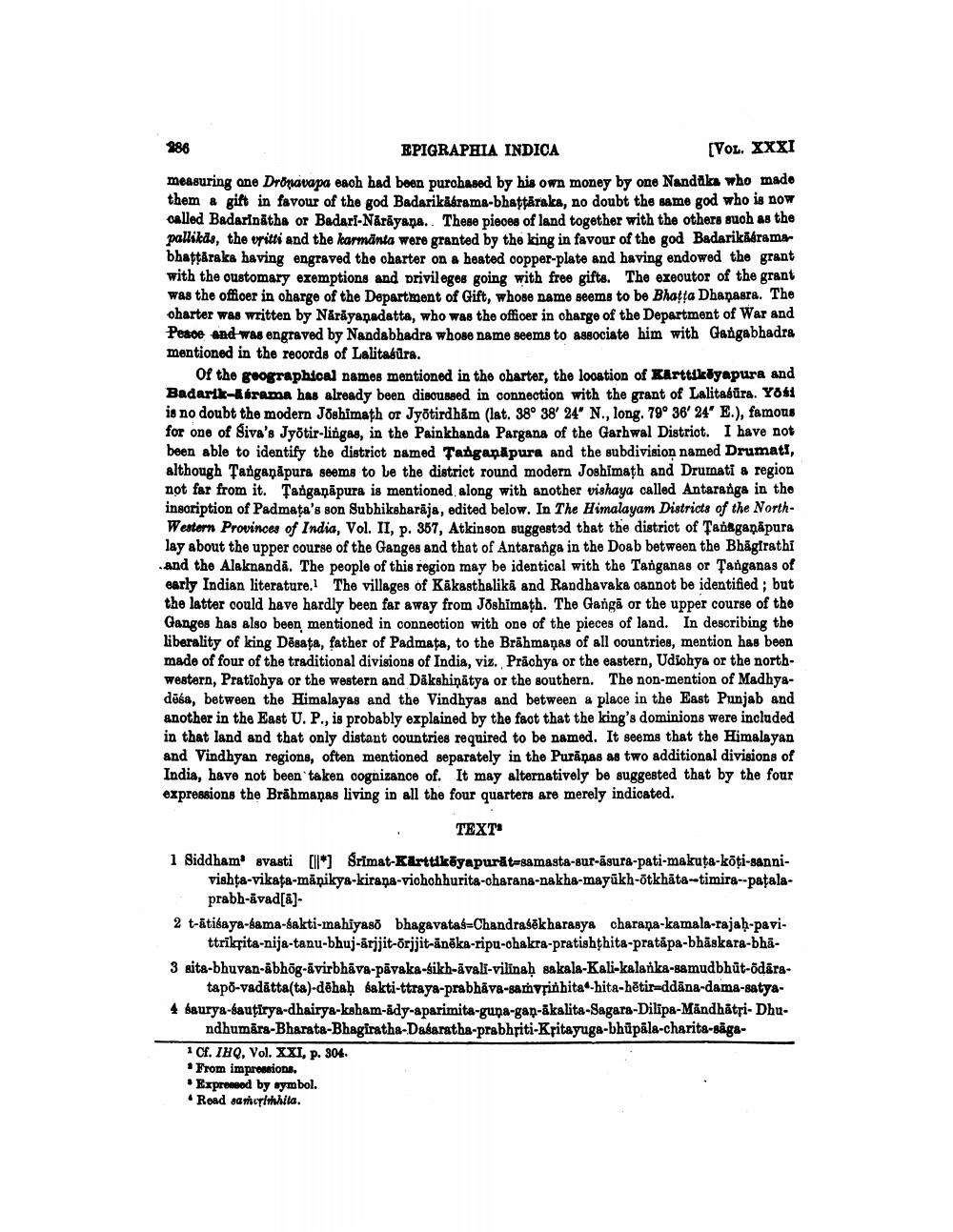________________
286
EPIGRAPHIA INDICA
[VOL. XXXI
measuring one Drönavapa each had been purchased by his own money by one Nandaka who made them a gift in favour of the god Badarikaárama-bhaṭṭāraka, no doubt the same god who is now called Badarinatha or Badari-Narayana.. These pieces of land together with the others such as the pallikas, the vritti and the karmanta were granted by the king in favour of the god Badarikäéramabhaṭṭaraka having engraved the charter on a heated copper-plate and having endowed the grant with the customary exemptions and privileges going with free gifts. The executor of the grant was the officer in charge of the Department of Gift, whose name seems to be Bhatta Dhanasra. The oharter was written by Narayapadatta, who was the officer in charge of the Department of War and Peace and was engraved by Nandabhadra whose name seems to associate him with Gangabhadra mentioned in the records of Lalitasura.
Of the geographical names mentioned in the charter, the location of Kärttikäyapura and Badarik-Asrama has already been discussed in connection with the grant of Lalitasūra. Yōsi is no doubt the modern Joshimath or Jyotirdham (lat. 38° 38′ 24′′ N., long. 79° 36′ 24′′ E.), famous for one of Siva's Jyotir-lingas, in the Painkhanda Pargana of the Garhwal District. I have not been able to identify the district named Tanganapura and the subdivision named Drumati, although Tanganapura seems to be the district round modern Joshimath and Drumati a region not far from it. Tanganapura is mentioned along with another vishaya called Antaranga in the insoription of Padmata's son Subhiksharaja, edited below. In The Himalayam Districts of the NorthWestern Provinces of India, Vol. II, p. 357, Atkinson suggested that the district of Tanaganapura lay about the upper course of the Ganges and that of Antaranga in the Doab between the Bhagirathi and the Alaknanda. The people of this region may be identical with the Tanganas or Tanganas of early Indian literature. The villages of Kakasthalika and Randhavaka cannot be identified; but the latter could have hardly been far away from Joshimath. The Ganga or the upper course of the Ganges has also been mentioned in connection with one of the pieces of land. In describing the liberality of king Desata, father of Padmata, to the Brahmanas of all countries, mention has been made of four of the traditional divisions of India, viz., Prachya or the eastern, Udichya or the northwestern, Pratichya or the western and Dakshinatya or the southern. The non-mention of Madhyadesa, between the Himalayas and the Vindhyas and between a place in the East Punjab and another in the East U. P., is probably explained by the fact that the king's dominions were included in that land and that only distant countries required to be named. It seems that the Himalayan and Vindhyan regions, often mentioned separately in the Puranas as two additional divisions of India, have not been taken cognizance of. It may alternatively be suggested that by the four expressions the Brahmaņas living in all the four quarters are merely indicated.
TEXT
1 Siddham svasti [*] Srimat-Kärttikēyapurāt-samasta-sur-asura-pati-makuta-kōti-sanni
vishţa-vikața-māņikya-kirapa-vichohbarita-obarana-nakha-mayakh-ötkhäta-timira--patala
prabh-ivad[A].
2 t-tilaya-lama-lakti-mahiyas bhagavatas-Chandrasekharasya charana-kamala-rajab-pavittrikita-nija-tanu-bhuj-ärjjit-örjjit-ānēka-ripu-chakra-pratishthita-pratāpa-bhiakara-bhi
3 sita-bhuvan-ābhōg-āvirbhāva-pāvaka-sikh-āvali-vilinaḥ sakala-Kali-kalanka-samudbhūt-ōdāratapo-vadātta(ta)-dehaḥ sakti-ttraya-prabhava-samvṛinhita -hita-hētir-ddana-dama-satya
4 saurya-sautirya-dhairya-ksham-ady-aparimita-guna-gan-akalita-Sagara-Dilipa-Mandhātri- Dhundhumira-Bharata-Bhagiratha-Dasaratha-prabhriti-Kritayuga-bhūpāla-charita-alga
1 Cf. IHQ, Vol. XXI, p. 304.
From impressions.
*Expressed by symbol. Read samerimhita.




